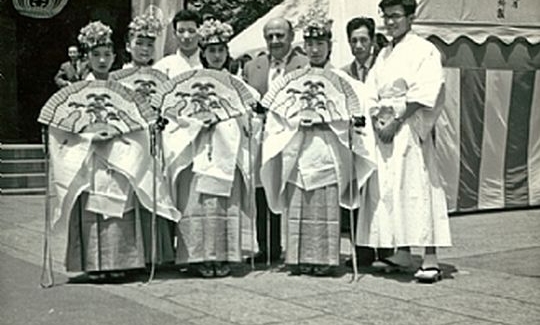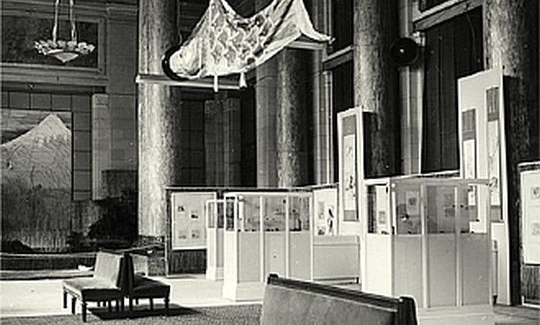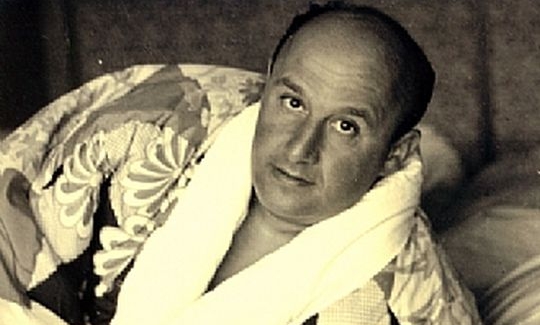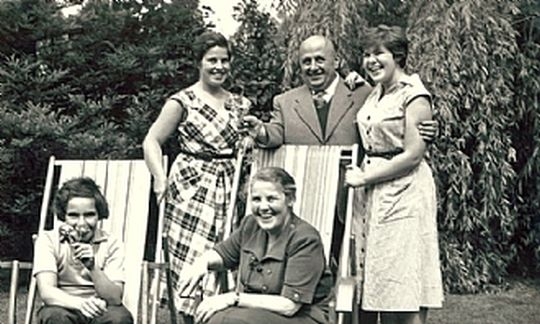The early years (1893-1918)
"I was born on Columbus Day, October 12, 1893, an excellent wine year, in the fortress and garrison town of Glogau on the Oder River in Silesia (now Poland) [...] The name Tikotin is neither Japanese nor a pseudonym but was adopted by my ancestors when they came to Germany from the town of Tykocin in Poland."
Felix Tikotin was the fourth child in a family of three daughters and four sons. When he was nine years old the family moved to Dresden, where Tikotin attended the gymnasium. He wanted to be a painter, but his parents would not let him. As a compromise he studied architecture at the Technical College in Dresden and earned some money writing art reviews for magazines.
"In 1911 the director of the Odol mouthwater factory organized an exhibition called "Hygiene", where I had my first confrontation with Japanese prints. The Japanese pavilion was a model of a Japanese field hospital used in the Russian-Japanese War. Because of its architectural style, it was, of course, very interesting to me. Inside the pavilion were Japanese woodcuts depicting scenes from the war by artists such as Gekko. At the end of the exhibition these prints, mostly triptychs, were sold for about 0.10 Marks apiece, and I bought as many as I could afford."
In 1914, at the onset of WW1, Tikotin was mobilized into the German Emperor's army. He became a cavalry officer. On his 21st birthday his unit was dispatched to Belgium, and participated in the bloody battles at Ypres and on the Somme. Towards the end of the war, after his eldest brother had been killed, he was moved to Galicia where he spent a relatively quiet time stationed in the house of a local Jewish family.
"During one of my leaves, I decided to interrupt my journey at Cracow. There I saw an exhibition of Japanese prints, mainly by Hiroshige, from the Jasienski Collection".
Success as an art dealer (1919-1933)
After the war, Tikotin worked as an architect for the City of Dresden for a short time. He also dealt in art books and paintings, and became friendly with the "Brücke" (The Bridge) group of expressionist painters, from whom he was able to buy paintings. At that time he decided to make his hobby into his profession, and left architecture in favuor of art dealing. By selling his collection of art books and paintings Tikotin was able to become a full-time art dealer. He travelled to London and Paris and bought his first collections of Japanese prints. An important influence on his choice of Japanese art was Woldemar von Seidlitz, Director of the Kupferstich Kabinett (print room) in Dresden, who wrote one of the first Western books on Japanese art in 1888, and gave Tikotin his first Japanese print (by Utamaro).
Tikotin started his first gallery in Dresden. In 1927 he moved to Berlin, where he rented a large space on the Kurfürstendamm. This gallery opened in April 1927 with a stylish event at midnight and an exhibition of Japanese ghost prints, many of which are still in the Museum.
Berlin in those days was the centre of the cultural world. A circle of people was interested in Japan and Japanese art; the Society for Eastern Art ("Gesellschaft für Ostasiatische Kunst") published a monthly journal in which Tikotin advertised his gallery. Tikotin met Fritz Rumpf, a Japanologist connected with the newly opened Japan Institute (founded in 1926). Rumpf became a very good friend, and accompanied Tikotin on his first trip to Japan. He also wrote the catalogue texts for a number of exhibitions. Otto Kümmel, Director of the Berlin museums, also wrote catalogue texts for Tikotin's exhibitions and initiated an exhibition of Tikotin's collection in 1933 at the Danish Royal Palace, despite the fact that he was a renowned Nazi who worked closely with Goebbels.
Tikotin visited Japan several times, travelling on the Trans-Siberia Express, which allowed him to return with goods and prints. In Japan he contacted Japanese art dealers, including Watanabe Shozaburo, founder of the "Shin Hanga" movement of modern Japanese print artists. He bought and sold prints, with the help of Fritz Rumpf and his agent and friend Johannes Barth. In Japan there was a demand for expensive prints that Tikotin could buy in Europe, and in return he could buy less-known prints and drawings very cheaply. In Tokyo there was a group of German expatriates interested in Japanese culture, one of whom was Wilhelm Solf, the German Ambassador and an enthusiastic print collector. Tikotin would later exhibit his collection in Berlin. Next to his art gallery, Tikotin opened a boutique of Japanese handicrafts and household articles, managed by his friend Salz.
Holland and beyond (1933-1938)
After the rise of Hitler, Tikotin's business continued to do well, and his reputation was such that Kümmel asked him to exhibit his collection as a representative of the City of Berlin in Copenhagen. After the exhibition closed, he returned to Copenhagen to oversee the packing and expedition of the items, and was met by his friend, the Danish banker Henriques who told him about the fire in the Reichstag and advised him not to return the items of the exhibition to Berlin. Thus the collection reached Amsterdam and Tikotin himself followed. He rented an apartment on the Prinsengracht, donated a precious item to the Rijksmuseum and opened his first exhibition in Amsterdam in the "Leesmuseum" in May 1933, shortly after arriving.
From 1933 to 1936 Tikotin organized exhibitions in Basel, Zurich, Antwerp, London and the Netherlands. He became internationally known as a leading promoter of Japanese art in Europe.
His future wife Eva Licht arrived in Amsterdam in 1935 as a refugee from Berlin. She found a job with Tikotin as his secretary/assistant, and in 1936 he asked her to accompany him on a business trip to the United States and Japan. Tikotin proposed to Eva on board the ship travelling to the United States. Upon arrival in the morning they were met by a friend who arranged for them to marry that same day in New York. They travelled around the United States, meeting customers, museum directors and friends, and decided on Seattle as the ideal place for settling down after returning from Japan.
From San Francisco they sailed to Japan where Tikotin already had many friends and business contacts. They lived for a few months in one of the first western-style apartment buildings in Tokyo. Tikotin bought and sold many items and collected art works and merchandise to ship back to the US. The ship was later torpedoed and the cargo was lost, but fortunately Eva and Tikotin were not on board.
Back in the US, they learned that Tikotin's mother Minna had managed to escape to Holland and needed help. They therefore returned to Holland to take care of her in a big house at Nassauplein in The Hague. On the ground flour Tikotin opened a gallery and employed a young Japanese named Hara Junzo, who lived with them and repaired prints and mounted kakemono scrolls for Tikotin. In 1937 Tikotin was instrumental in founding the Society for Japanese Art in Holland, and regular study-meetings were held in his home. Their first daughter, Helene, was born in 1938; their second, Johanna, in 1939. Their house in The Hague became a transit site for friends and relatives from Germany, and Tikotin helped them obtain visas for England and the United States.
During the occupation (1940-1945)
The first few months after the German invasion of the Netherlands (May 10th 1940), Tikotin was still able to organize exhibitions, but in September of that year the family was forced to leave The Hague within forty-eight hours. They moved to Alphen a/d Rijn, a small provincial town, where they lived for another year until they were ordered by the Germans to report, and were assisted by an Evangelical resistance group to find refuge. They hid in various places, often with farmers in the countryside around Woerden and Amsterdam. The two little girls were separated from their parents while in hiding. Tikotin was able to safeguard most of his collection, but at the end of the war all the lacquerware and netsuke were stolen. More than five years later, in 1950, the Dutch police caught smugglers trying to cross the border with their loot and everything was returned to him.
(1945-1960) Expansion and new goals
After the war Tikotin's business slowly improved, despite travel restrictions and the animosity towards anything Japanese in the Netherlands. The Dutch East Indies had been occupied by the Japanese, and it was hard to convince people that art was above hatred and could restore confidence.
A third daughter, Cecilia was born in 1946. Tikotin organized many exhibitions in the Netherlands, Brussels, Bern, Paris, London and even New York on themes ranging from prints to netsuke to ceramics to Japanese crafts. A highlight was a huge exhibition of drawings by Rembrandt, Hokusai and van Gogh in cooperation with Vincent van Gogh, nephew of the painter and owner of the van Gogh collection, and Willem Sandberg, Director of the Municipal Museum in Amsterdam. The exhibition travelled from Amsterdam to Basel and eventually to Tokyo.
In 1950 the family moved to Wassenaar where Tikotin laid out a small Japanese garden and redecorated the garden house in Japanese style, with shoji (sliding doors) and a tokonoma (a niche).
The Tikotin Museum of Japanese Art in Haifa
The idea of a museum in Haifa arose towards the end of the 1950s when it became clear that Tikotin's daughters were not interested in continuing in his footsteps. His daughter Helene (Ilana) had moved to Israel in 1956. Tikotin visited her, and was impressed with the positive energy of the new state. A second factor was the high Dutch taxes on art collections, based on their market value. Tikotin decided to donate his collection to the City of Haifa after having met with Mayor Abba Khoushy. He acquired a magnificent plot on the summit of Mount Carmel. From 1957 to 1960 Tikotin helped with the planning, and raised funds and support for the museum all over Europe and in Japan. Max Loeb built the exhibition gallery and Professor Chisaburo Yamada was its first director when the museum opened in May 1960.
Life in Switzerland (1960-1986)
Tikotin's idea of settling in Haifa never materialized. He decided to settle in Switzerland, near Lake Geneva, on a hill above Vevey overlooking the lake. He received his customers and friends at his house in Mont Pelerin, and continued to travel and do business for many more years. He died in 1986.




